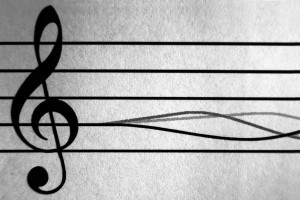In physics theory and practice, two sound waves can completely cancel each other out if they are equal and opposite.
Noise canceling headphones take advantage of this phenomenon.
When a group of musicians play together, it doesn’t cancel out, but the ranges can either complement each other or interfere.
If the saxophone and piano are playing in the same range, the combination can get muddy.
In a saxophone section in a big band, you generally have two tenors, two altos, and a bari. Not five tenors!
Having the different saxophones gives each saxophone a role.
If you play a C and a C# that are right next to each other, it sounds dissonant. But if you play a C and the C# an octave and a half step above, then it sounds pretty.
Another thing to think about is that the low notes are much closer to each other in terms of frequency than higher notes.
The frequency doubles for each octave.
So an A at 110 and 220 are 110 Hz apart while the next octave will be 220 Hz apart.
That means that a chord higher up in range will have greater pitch differences between each note and will sound ‘cleaner’.




Leave a Reply